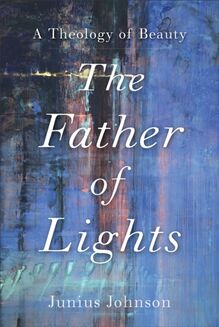Father of Lights (Theology for the Life of the World) , livre ebook
153
pages
English
Ebooks
2020
Vous pourrez modifier la taille du texte de cet ouvrage
Obtenez un accès à la bibliothèque pour le consulter en ligne En savoir plus
Découvre YouScribe et accède à tout notre catalogue !
Découvre YouScribe et accède à tout notre catalogue !
153
pages
English
Ebooks
2020
Vous pourrez modifier la taille du texte de cet ouvrage
Obtenez un accès à la bibliothèque pour le consulter en ligne En savoir plus
Publié par
Date de parution
29 septembre 2020
Nombre de lectures
0
EAN13
9781493427208
Langue
English
Poids de l'ouvrage
3 Mo
Publié par
Date de parution
29 septembre 2020
EAN13
9781493427208
Langue
English
Poids de l'ouvrage
3 Mo
Cover
Half Title Page
Series Page
Jesus Christ is God come to dwell among humans, to be, to speak, and to act “for the life of the world” (John 6:51). Taking its mandate from the character and mission of God, Christian theology’s task is to discern, articulate, and commend visions of flourishing life in light of God’s self-revelation in Jesus Christ. The Theology for the Life of the World series features texts that do just that.
Human life is diverse and multifaceted, and so will be the books in this series. Some will focus on one specific aspect of life. Others will elaborate expansive visions of human persons, social life, or the world in relation to God. All will share the conviction that theology is vital to exploring the character of true life in diverse settings and orienting us toward it. No task is greater than for each of us and all of us together to discern and pursue the flourishing of all in God’s creation. These books are meant as a contribution to that task.
Title Page
Copyright Page
© 2020 by Junius Johnson
Published by Baker Academic
a division of Baker Publishing Group
PO Box 6287, Grand Rapids, MI 49516-6287
www.bakeracademic.com
Ebook edition created 2020
All rights reserved. No part of this publication may be reproduced, stored in a retrieval system, or transmitted in any form or by any means—for example, electronic, photocopy, recording—without the prior written permission of the publisher. The only exception is brief quotations in printed reviews.
Library of Congress Cataloging-in-Publication Data is on file at the Library of Congress, Washington, DC.
ISBN 978-1-4934-2720-8
Unless otherwise noted, Scripture quotations are from The Holy Bible, English Standard Version® (ESV®), copyright © 2001 by Crossway, a publishing ministry of Good News Publishers. Used by permission. All rights reserved. ESV Text Edition: 2016
Scripture quotations labeled NIV are from the Holy Bible, New International Version®. NIV®. Copyright ©1973, 1978, 1984, 2011 by Biblica, Inc. TM Used by permission. All rights reserved worldwide. www.zondervan.com.
Scripture quotations labeled NKJV are from the New King James Version®. Copyright © 1982 by Thomas Nelson. Used by permission. All rights reserved.
Scripture quotations labeled NRSV are from the New Revised Standard Version of the Bible, copyright © 1989 National Council of the Churches of Christ in the United States of America. Used by permission. All rights reserved.
Dedication
Soli Trinitati Gloria Deus gaudii supermaximi, omnibenefaciens, vobis sit laus omnium creaturarum, in vos omnis intentio et desiderium; in vobis opus hoc et omnes lectores requiescant saecula usque ad saeculorum.
For my wife, Rebekah, my partner, friend, and one true love: your magnificence and grace underlie every page of this book.
For the many ways in which you tirelessly, and too often thanklessly, remind me of the glory of God, I thank you, and I pray that in this book you will find some reflection of the glory you have so faithfully and powerfully reminded me of these many years.
Epigraph
Do you not know? Do you not hear?
Has it not been told you from the beginning?
Have you not understood from the foundations of the earth?
Isaiah 40:21
Contents
Cover i
Half Title Page ii
Series Page iii
Title Page iv
Copyright Page v
Dedication vi
Epigraph vii
Detailed Contents ix
Acknowledgments xiii
Introduction 1
PART 1 The Encounter with Beauty 15
1. Eternity in Our Hearts: Memory, Beauty, and Divinity 17
2. The Eyes of Faith: Contuition and Spiritual Vision 43
3. Beauty and Analogy 71
PART 2 The Meaning of Beauty 85
4. Word and Concept: The Nature of Language 89
5. Concept Squared: The Nature of Metaphor 113
6. Res and Concept: Things as Signs 131
7. Res Sacramenti : The Nature of Sacraments 143
8. Radiant Res : Icons and Ecstasy 171
Postscript 189
Bibliography 195
Index 199
Cover Flaps 211
Back Cover 212
Detailed Contents
Acknowledgments xiii
Introduction 1
Defining the Question 2
Three Senses of the Word “Beautiful” 2
Our Concern: Beauty Broadly Speaking 4
The Challenge of the Ugly 8
An Ugly World 8
Structure of the Work 12
PART 1 The Encounter with Beauty 15
1. Eternity in Our Hearts: Memory, Beauty, and Divinity 17
Characteristics of Beauty 18
Pre-argumentative 18
Imperative 19
Subjective 20
Expansive 20
The Theological Definition of Beauty 21
Corollaries 24
C OROLLARY 1: It is not only through the physical that we approach beauty. 24
C OROLLARY 2: Longing for that which is not present in the desired way is an integral part of the experience of the beautiful. 25
C O R O L L A R Y 3: The experience of the beautiful, properly speaking, is of creatures. 27
C OROLLARY 4: God is the remote yet proper referent in the experience of the beautiful. 29
C OROLLARY 5: However much the beautiful creature is dear to us for its own sake, it is more importantly dear to us for God’s sake. 30
C OROLLARY 6: Because what reminds one person may not be the same as what reminds another person (for various reasons), the subjective element in the experience of beauty is irreducible. 31
Preliminary Conclusion: Subjective Objectivity 32
Beauty in an Ugly World 33
Understanding Ugliness 33
Beauty and the Rejection of God 39
2. The Eyes of Faith: Contuition and Spiritual Vision 43
The Need for Eyes of Faith 46
The Importance of Vision 47
The Nature of Vision 49
Divine Vision 49
From Uncreated to Created Vision 51
Angelic Vision 53
Human Vision 54
The Nature of Contuition 56
Contuition and Beauty 57
Implicit Contuition 57
Explicit Contuition 59
Subjective Objectivity Explored 62
Symphonic Witness: Virtuosity and the Experience of the Beautiful 62
Transgressing the Object: Blasphemy and the Ugly 65
Conclusion: Analogical Expansion to the Rest of Human Experience 67
3. Beauty and Analogy 71
The Nature of Analogy in General 72
A General Definition of Analogy 72
Analogical Complexes 76
The Nature of the Analogia Entis 80
PART 2 The Meaning of Beauty 85
4. Word and Concept: The Nature of Language 89
Realist and Relativist Linguistics 90
Signifier and Signified 90
Linguistic Relativism 90
Linguistic Realism 91
Adjudicating the Positions 93
Theological Considerations 95
God’s Creative Speech: Calling Things That Are Not 96
Naming the Animals: An Irrevocable Choice 99
Babel: The Shattering of Language 102
Pentecost: Proleptic Restoration 107
Language and Beauty 108
Subjective Objectivity: Naming and Beauty 108
The Subjective Concern: Babel and Beauty 109
The Objective Ground: Pentecost and Beauty 110
5. Concept Squared : The Nature of Metaphor 113
Defining Metaphor 113
Metaphor and Analogy 113
Metaphor and Contuition 115
Ad Placitum Institution and Human Invention 115
Contuitio ad Placitum Instituta 117
The Dynamics of Metaphor 119
Accretion of Meaning 119
C OMPLEXITY OF M EANING 122
C OMPLEXI TY OF I NTERPRETATION 124
Metaphorical Complexes 125
Metaphor and Beauty 127
6. Res and Concept: Things as Signs 131
The Sign Character of Things 131
Res as Signs 132
The Opacity and Transparency of Res 136
O PACITY 136
T RANSPARENCY 138
T RANSLUCENCE 139
Signs and Beauty 139
Herrlichkeit and the Objective Res 139
I NDEPENDENCE : Herrlichkeit as Sovereignty 140
T RANSPARENCY , O PACITY , AND I NCARNATIONAL L OGIC : Herrlichkeit as Glory 141
7. Res Sacramenti: The Nature of Sacraments 143
The General Concept of Sacrament 144
Secular Quasi-sacraments 146
Quasi-sacramental Elements: Culture and Artifacts 147
Quasi-sacramental Institution: The Assignation of Meaning 151
Confection: Real Presence and the Quasi-sacramental Elements 154
Quasi-spiritual Eating: Anamnesis and Incorporation 156
The Limits of Quasi-sacraments 157
Cross as Crux 158
Divine Sacraments 160
Sacramental Elements: Promptness and Natural Suitability 160
Sacramental Institution: Res Realized 161
Real Presence: The Union of God and the Sacramental Creature 162
Spiritual Eating: Transformation and Conversion 163
Sacraments versus Quasi-sacraments 164
Sacraments and Beauty 165
The Dynamics of the Sacrament in Relation to Beauty 165
Suffering, Darkness, Pain, and Beauty 167
8. Radiant Res : Icons and Ecstasy 171
The Nature of Icons 171
Distinguishing Icons from Sacraments 172
Icons and Thick Signification 176
O THERNESS 176
D EPTH 179
The Efficacy of the Icon 181
Icons and Beauty 184
Beauty and Thick Signification 184
O THERNESS 184
D EPTH 185
Beauty and Ecstasy 185
T HE R APTURING P OWER O F B E A U T Y 185
T H E T R A N S F O R M ATIVE P OWER OF B EAUTY 187
Postscript 189
Beauty and Desire 190
Beauty and Fulfillment 191
Bibliography 195
Index 199
Acknowledgments
This book began when I was a teenager and newly converted to the Christian faith. I found that knowledge of the trinitarian God and the magnificent Christ were opening to me all the deep questions I had struggled with in my youthful arrogance. I had at the time as a most faithful and apt companion Rebecca Dennison, a friend who listened to all of my discoveries with a mixture of joy (for what was new to her) and indulgence (for the things she had never not known). But for all the progress I was making, I felt that one question very dear to me was eluding me: the nature of beauty. When I told her this, she responded without hesitation: “Oh. Beauty is what reminds you of God.” I fell into her claim as Alice fell into the rabbit hole. In the twenty-five years since that time, I have never ceased to try to find a way to express the simplicity and fecundity of that insight that could in some way do justice to how it became a center around which my life has been ordered. With this book, I at last repay this debt.
More recently, I am indebted to the Anselm Society of Colorado Springs, whose generous invitation to speak to them provided the occasion for the talk that eventually became the first chapter. Likewise I am indebted to the




